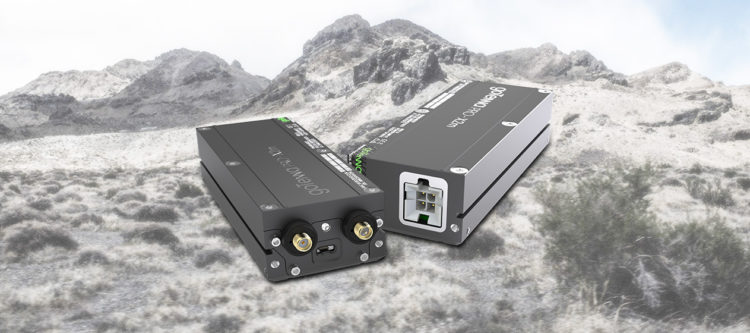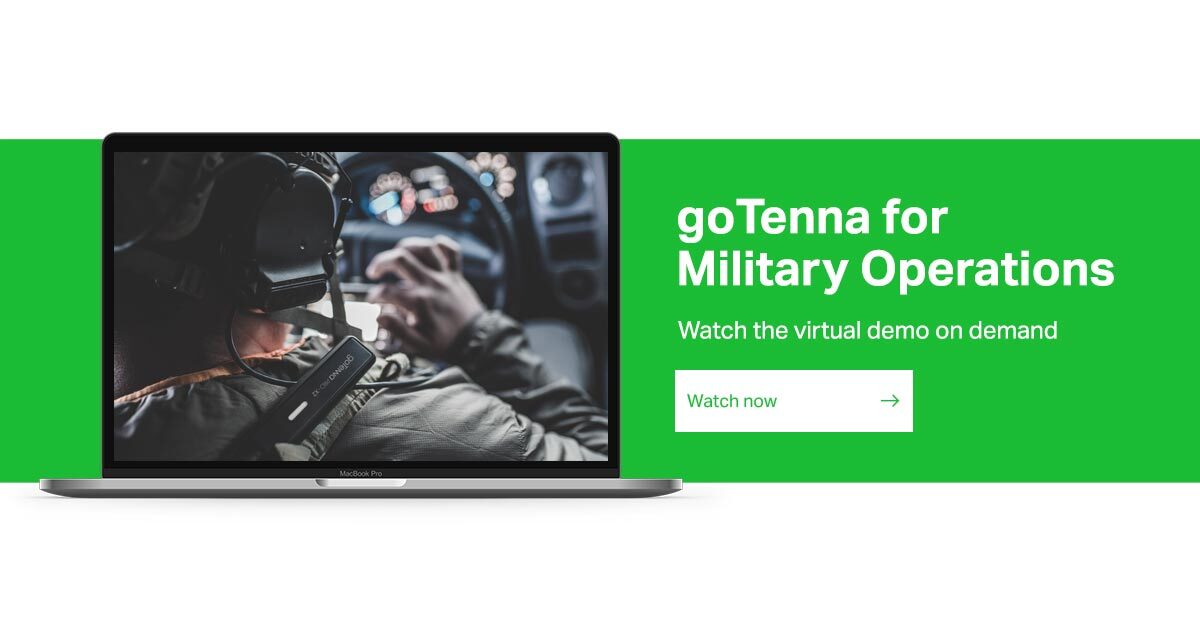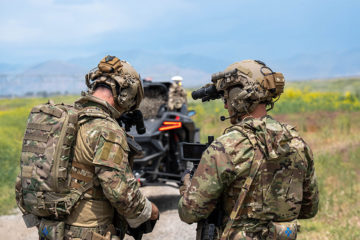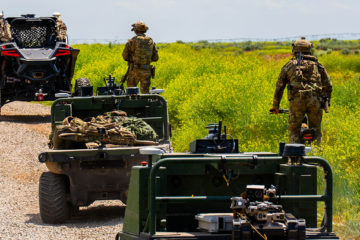goTenna Pro X2m brings mobile mesh networking to military and public sector platforms

Earlier this week, goTenna introduced the newest addition to its portfolio of mobile mesh networking solutions, the goTenna Pro X2m.
Unlike other goTenna mobile mesh networking radios, this new solution is not intended to be carried by operators in the field. Instead, this new solution is meant to be integrated into a wide range of military and law enforcement platforms and vehicles, effectively adding mobile mesh networking capabilities to the other communications alternatives in their PACE plan.
But why would original equipment manufacturers (OEMs) want to integrate mobile mesh networking into next-generation unmanned aerial vehicles, unmanned surface vehicles, ships, and aircraft? What capabilities will tactical operators get from connecting these platforms to mobile mesh networks? And why would OEMs want to integrate a goTenna Pro X2m into their vehicles?
We sat down with Chris Pietrzak, the Vice President of Solutions Architecture at goTenna, to find out.
The Last Mile (TLM): How does the goTenna Pro X2m integrate into military and law enforcement platforms, such as unmanned aerial vehicles (UAVs) and others? Is significant engineering required to integrate it into new or legacy platforms?
Chris Pietrzak: What makes the goTenna Pro X2m different from the traditional goTenna Pro-X2 is its modular design and lightweight form factor. It was purpose-built to integrate seamlessly into modern military and law enforcement vehicles and platforms.
The diversity of systems and use cases makes creating a “plug-and-play” solution that integrates into every platform or vehicle difficult. However, the Pro X2m was built to integrate as easily as possible.
There are three separate connectors—one for power, one for data, and one for the antenna. From a physical standpoint, once the OEM or integrator has contemplated all design considerations and worked to identify the best location within the vehicle or platform for the Pro X2m, they simply need to connect the device to the platform’s systems via those three connectors.
There is a fairly high degree of simplicity. However, it ultimately comes down to the complexity of the systems into which it’s being integrated.
TLM: We’ve heard many stories of operators finding creative ways to attach a goTenna Pro-X2 to their support systems – be it drones, vehicles, or balloons. Why is integrating a Pro X2m into a platform superior to just attaching a traditional Pro-X2 to a vehicle with cordage or tape?
Chris Pietrzak: While the goTenna Pro-X2’s battery is excellent and can provide hours of connectivity, some use cases—such as using the radio as a repeater on a particularly “chatty” network—can drain the battery quickly. This can also outpace the battery’s ability to recharge via USB connection, especially in austere environments where solar charging is often necessary
“THE PRO X2M GIVES THE OEM–THE ORGANIZATION THAT KNOWS THE PLATFORM BEST–THE OPPORTUNITY TO IDENTIFY THE OPTIMAL POSITION OR LOCATION FOR THE DEVICE WITHIN THE VEHICLE, AND ALSO TO BE REGULATORY-APPROPRIATE FOR SYSTEMS LIKE AERO, WHICH REQUIRE CERTIFICATION.” –CHRIS PIETRZAK
The goTenna Pro X2m has no battery. Its power comes from the vehicle into which it’s integrated. That means the Pro X2m can effectively be powered in perpetuity – enabling it to provide critical communications and situational awareness capabilities for the duration of the mission.
We also have to recognize that duct-taping a device onto a vehicle or platform is not an ideal solution. The device may not be placed in the optimal position, and it may impact wind resistance or the flightworthiness of some aerial vehicles. It’s simply not the ideal mechanical integration. The Pro X2m gives the OEM—the organization that knows the platform best—the opportunity to identify the optimal position or location for the device within the vehicle, and also to be regulatory-appropriate for systems like aero, which require certification.
Finally, integrating the Pro X2m with the platform’s systems provides more functionality and capability. When we’ve talked about operators taping their goTenna Pro-X2 radios to UAVs or tying them to towers or trees with cordage, they’ve mostly been doing so to increase the radios’ range so they could serve as more effective relays.
When the radio is integrated into the platform, it can do more than serve as a repeater or a way to see a vehicle’s physical location on a map. It can pass data generated by that platform or vehicle to other stakeholders connected to the mobile mesh network.
TLM: Why would an OEM that makes maritime or aerial platforms or other vehicles want to integrate the Pro X2m into their platform? How does this make their platform more capable for military and government users?
Chris Pietrzak: It really depends on the use case, but integrating the goTenna Pro X2m into platforms and vehicles will provide the end user with numerous new capabilities.
“…EVERY NEXT-GENERATION OF LEGACY PLATFORM OR VEHICLE SHOULD BE ENABLED WITH AN INTEGRATED MOBILE MESH NETWORKING DEVICE, SUCH AS THE GOTENNA PRO X2M. IT WAS BUILT TO SEAMLESSLY AND EASILY INTEGRATE WITH THESE PLATFORMS, MAKING IT A RELATIVELY EASY LIFT TO IMPLEMENT…” –CHRIS PIETRZAK
For terrestrial vehicles, the integration of mobile mesh networking capabilities can increase situational awareness. There is value in humans knowing exactly where their vehicles and platforms are, and there is also value in vehicles and platforms knowing exactly where humans are, such as when targeting effectors. It also provides a unique mounted and dismounted continuity, where the vehicle becomes a relay when the operators are dismounted. This layered approach brings unique value to increasing coverage in austere or comms-denied environments.
For aerial vehicles, there is the “bread and butter” capability that mobile mesh networking provides – placing a radio up high to serve as a relay – thereby creating a “bubble” of connectivity over a large geographic area. However, most modern aircraft have just as many sensors as effectors – maybe even more. Integrating mobile mesh networking into these platforms can help pass the data generated by these sensors to leaders on the ground who need that information to make timely, data-driven decisions.
For unmanned vehicles, there is the added value of providing fallback or emergency guidance. Mobile mesh networking can become part of the PACE plan for these platforms, enabling basic command and control functionality should other means of communication fail.
As you know, many UAVs are lost when the ability to communicate commands is denied. Should all other signals be lost, mobile mesh networking could collect the data generated by that UAV, and then operators could provide basic commands and coordinates to ensure that it completes its mission and returns safely. Typically, the goTenna mesh network has ranges that far exceed other primary link ranges, offering a perfect, alternative path for command and control of the UAV.
TLM: Exactly what types of vehicles could you envision the Pro X2m being integrated into? What benefits would integrating the Pro X2m into these different vehicles deliver?
Chris Pietrzak: Candidly, every next-generation of legacy platform or vehicle should be enabled with an integrated mobile mesh networking device, such as the goTenna Pro X2m. It was built to seamlessly and easily integrate with these platforms, making it a relatively easy lift to implement, and the benefits that it enables well surpass the relatively low cost of the device.
“FOR TERRESTRIAL VEHICLES, THE INTEGRATION OF MOBILE MESH NETWORKING CAPABILITIES CAN INCREASE SITUATIONAL AWARENESS. THERE IS VALUE IN HUMANS KNOWING EXACLTY WHERE THEIR VEHICLES AND PLATFORMS ARE, AND THERE IS ALSO VALUE IN VEHICLES AND PLATFOMS KNOWING WHERE HUMANS ARE…” –CHRIS PIETRZAK
Modern military and law enforcement operators rely on timely and accurate data and information. It’s mission-critical. Enabling platforms and vehicles with mobile mesh networking provides another avenue for passing essential mission data from sensors to those that need it.
Also, many military and law enforcement agencies and organizations are already equipping their tactical operators with body-worn mobile mesh networking devices, including the goTenna Pro-X2. Integrating mobile mesh networking into vehicles and platforms will enable them to connect seamlessly on the same network and interoperate with these operators, adding to their situational awareness and the data they can access about their environment.
The cost is low, and the gained capabilities are incredibly beneficial. OEMs have every reason to integrate the Pro X2m into their platforms and make them mobile mesh networking enabled.









No Comment